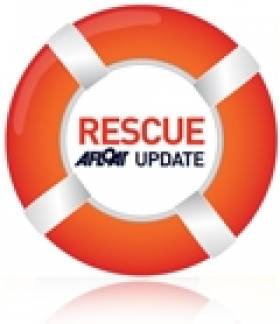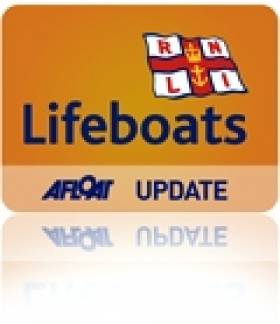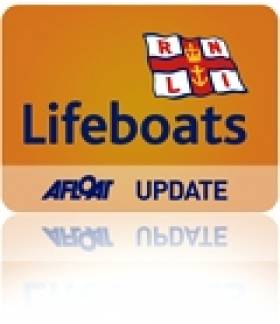Displaying items by tag: yacht
Is This The Oldest Yacht in the World?
#oldestyacht – Serenely she sits, with all the heightened elegance of a still beautiful grand dame who, despite a hectic youth, has lived long and well to take her place in a position of respect, verging on reverence, within the community. But then anyone, whatever the life they may have led, would be deserving of some sort of special appreciation if they'd managed to reach the age of 224 still in reasonably good order, still looking much as they did more than two centuries ago. Yet that is the case with the 26ft schooner yacht Peggy. When you attend upon her in her home in Castletown in the Isle of Man, it's as if time has stood still since the 1790s.
We sailed over to the Isle of Man recently for the Peel Traditional Boat Weekend. As it had been expanded to include the final Irish Sea gathering for the Old Gaffers Association Golden Jubilee, it was felt that the least we could do, before the revels began, was to pay our respects to the ultimate old gaffer of them all, across at her home port on the south coast of the island. And if the Peggy of Castletown isn't the oldest yacht in the world in more or less intact order, then we'll be fascinated to hear of any vessel having a better claim. For by any standards, the Peggy is extraordinary.
Thus we'll leave an account of the fantastic party in Peel for another day. It will be ideal for the depths of winter when such memories of enjoyment deserve to be savoured at leisure. But the Peggy deserves to be highlighted right now. For the fact is that if you're into boats and those who sailed them and their history, then the Peggy blows your mind. The story of her origins, of her adventures in sailing, and of how she has survived for more than 200 years, would the stuff of legend if it didn't happen to be completely true.
The story of the Quayle family of Bridge House right on the harbour in the ancient Manx capital of Castletown is long and distinguished. In the 18th Century, John Quayle was a leading figure in the administration of the Isle of Man. But though his son George Quayle (1751-1835) was a member of the Manx parliament, the House of Keys, for 51 years, he was also something of a Renaissance man, his interests as a successful merchant and ship owner including the co-founding of the Isle of Man's first bank, while his inventive talents were such that he won a gold medal of the Society of Arts.

George Quayle (1751-1835)
Despite the challenging nature of the waters around the Isle of Man, he was also an enthusiastic amateur sailor. So when the impressive Bridge House was being completed in 1789, he saw to it that its eastern end included a private dock accessed through an arch from Castletown Harbour, the dock in its turn giving access to a "boat cellar" in which he planned to have slipping facilities for a 26ft sailing boat he was having built nearby.
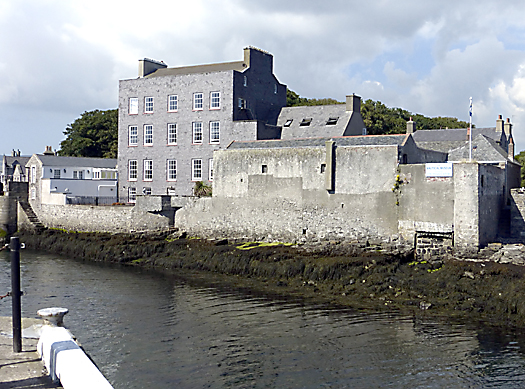
Bridge House, Castletown, IOM. George Quayle's quarters were on the right hand side of photo, and the blocked-off entrance to the Peggy's dock is at lower right. Photo: W M Nixon
It may well be that, like the J/24 some 174 years later, the size of the new boat Peggy was dictated by the size of the garage available. Whatever, there's no doubt she's a very neat fit in the boat cellar. George Quayle then provided a complete maritime unit around his new boat's berth, as he created his own personal quarters around it independent of the family home, the main feature directly above the Peggy's cellar being a fine living room replicating the Great Cabin of a sailing ship.

The first sight of the Peggy when you descend to the boat cellar is memorable, though it takes some time to grasp that this is a boat built 224 years ago. Photo: W M Nixon
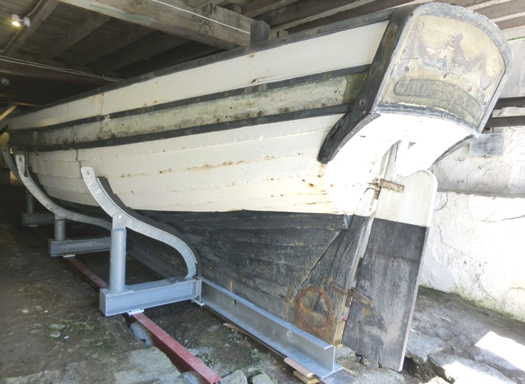
The stern is completely typical of its era Photo: W M Nixon
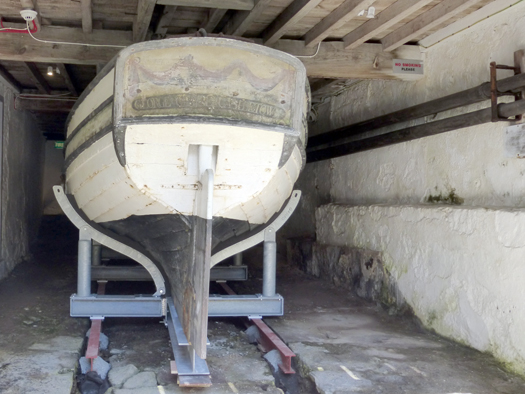
The sections reveal a hull with real speed potential. Note the original spars stowed on wall on right. Photo: W M Nixon
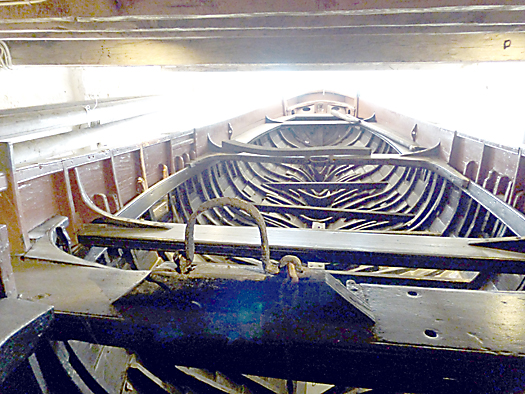
The interior reveals how the topsides were raised to increase sail carrying power. Photo: W M Nixon
With his new boat comfortably housed, and his own quarters cleverly created to shelter him from the demands of busy family life, most folk would have taken things easy for a while. But George Quayle was a bundle of energy. Although the boat was built in 1789, with the demands of completing the big new house, he doesn't seem to have started sailing the Peggy – named after his mother – until 1791. But once she was in action there was no stopping him, both in spirited sailing, and in re-configuring the boat to improve performance. So although the lower part of the hull of the Peggy is probably much as it as when she was built in 1789, as he increased the sail area of the already massive schooner rig he also raised the topsides in order to carry the extra cloth without having her fill. Even then, he still had extra canvas "boards" to keep the sea at bay.
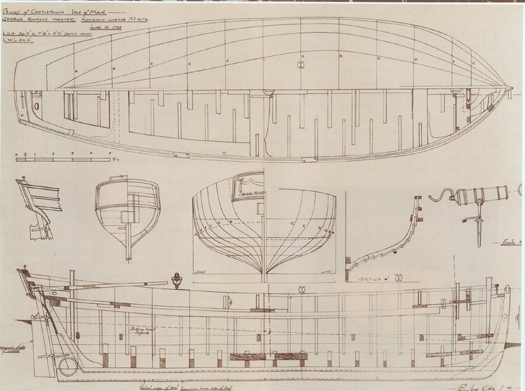
The construction details and hull lines were taken off in the 1930s after Peggy had been released following a century of entombment
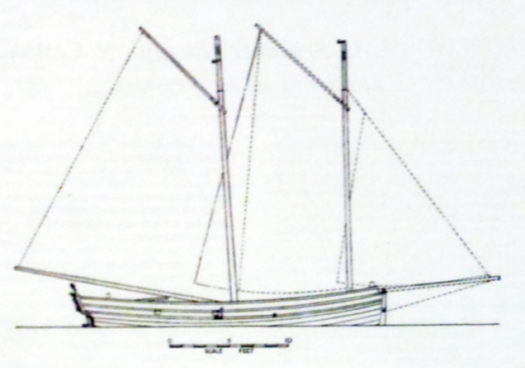
The sail plan is arguably a primitive version of that set by the schooner America 55 years later
The Peggy – complete with miniature yet very real armaments, as French privateers were active in the Irish Sea – was always considered a yacht, and Quayle was keen to race her and further improve performance. Thus he was soon experimenting with "sliding keels" to combat leeway, and the reputation of the Peggy became such that a challenge was set up to sail in a regatta against the only flotilla of other racing yachts within reach, across at Windermere in the English Lake District.
George Quayle was related to a leading figure in Windermere sailing, John Christian Curwen, who had a couple of sailing pleasure boats imported from the Baltic. Also on the lake was a supposedly hot sailing machine owned by one Captain Heywood. So in 1796, Peggy sailed across to Cumbria, and was carted up the half dozen or so miles from the inner reaches of Morecambe Bay to the lake, which is 128ft above sea level.
It was quite an effort, and as yacht racing organisation was only in its infancy in 1796, the results weren't totally clearcut, though it seems that the Peggy outsailed everything else by several country miles. Intriguingly, two other boats from this pioneering regatta have also survived, though not so well as Peggy. These were the two Baltic boats owned by John Christian Curwen. They were still intact until the 20th Century, but then were fire-damaged while in store. The sad remains of both were on display in a corner of the Windermere Steamboat Museum when I was there around twenty years ago, but largely ignored. Much more interesting was the discovery that George Quayle's relation John Christian Curwen was in turn related to Fletcher Christian of Bounty notoriety, who was of course a Cumberland man. Up among the lakes, they were happy to tell us that there's no way Fletcher Christian stayed on Pitcairn until the end of his days – he got home to the lakes some way or other, so it's said.
But meanwhile the Peggy only just made it home to the Isle of Man after her successful foray to Windermere. She'd a real pasting in the Irish Sea beating back to Castletown, but in typical style George Quayle turned this to best advantage, cheerfully reporting in a letter that the "sliding keels" so improved windward performance that they safely made it back to port.

The sailplan on the model is one interpretation of the abundance of spars available in the boat cellar Photo: W M Nixon
Today, in the boat cellar at Bridge House, you can see the Peggy and all the features which made her such an able flyer. She still has the slots through which George Quayle lowered his primitive centreboards, and on racks on the wall are the original spars she carried when in her racing prime. This indeed was and is a formidable racing machine, and it's no exaggeration to assert that, in her miniature style, she was an early example of the type which reached its supreme development with the schooner America.
And she has survived through a fortuitous miracle of preservation. The exact timing and circumstances in which it all happened are not precisely clear, but we know that after George Quayle died in 1835, the Peggy was entombed in her boat cellar, with the seaward entrance walled up. In time, the little dock was filled in, and the archway through to Castletown harbour closed off. Yet with the pervading salty air, this provided an ideal environment for boat preservation. When it was all opened up again in the 1930s, there was the Peggy, still in remarkably good order, still the same little ship which had successfully completed such a gallant expedition to Windermere in 1796.
Today, George Quayle's quarters in Bridge House accommodate the Manx Nautical Museum, with the Peggy – now formally owned by the Manx nation - the prime exhibit. But with every passing year, she becomes ever more important, so much so that 2014 will see a comprehensive project to conserve her, and in time - let us hope - put her on more accessible display with her full racing rig in place.
With imaginative design, it could possibly be done by putting a clear roof over the little dock. I didn't pace it out when we were there a couple of weeks ago, but guessing from the photos, it should be just about feasible to accommodate her there with all sail set.
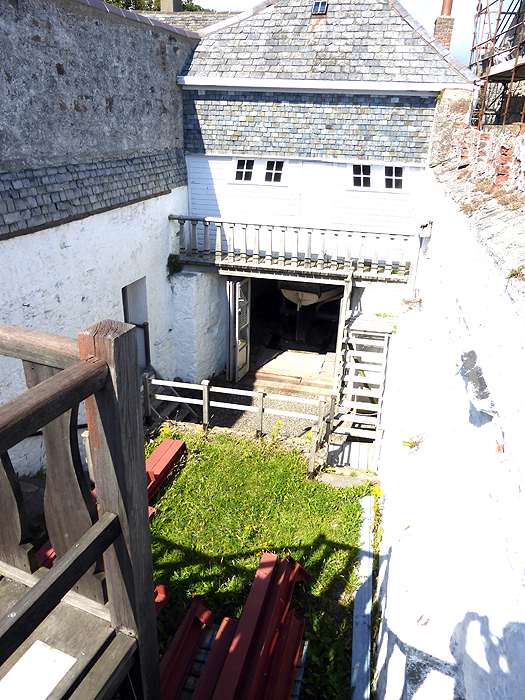
The former dock, now filled in, where Peggy was berthed before hauling into the boat cellar - note her stern just visible in doorway, while the windows in the room above reflect sailing ship Great Cabin style. This former dock could be re-configured for use as a covered display area where the newly conserved Peggy could be put on show fully rigged. Photo: W M Nixon
And after 224 years, she surely deserves a proper display. But for now, there are the intriguing challenges of conservation. Most of the timber is in remarkably good order, but the fastenings need replacing, as apparently they are "mineralising". That sounds remarkably like good old-fashioned rust to you and me, but "mineralising" is a word to cherish. So it won't surprise you to learn that, after the earnest piety of our visit to the Peggy, my shipmates then threw themselves into the festivities and fabulous hospitality of the Peel Traditional Boat Weekend with such enthusiasm that we were undoubtedly in a mineralised condition as we slugged our way back home across the Irish Sea.
Navy Tows Stricken Norwegian Yacht To Shore
#Rescue - RTÉ News reports that a Norwegian couple have been rescued after their yacht suffered damage off the south coast.
The vessel sailed by the couple in their late 60s apparently dismasted some 160 miles off the Cork coast en route from the Azores to the Shetland Islands.
They were discovered by a passing fishing trawler early yesterday (21 May) and assisted last night by the Naval Service vessel LE Aoife, which is currently towing the stricken yacht to Castletownbere.
Lt Captain Erica Downing of the LE Aoife told RTÉ that the couple were "extremely lucky" to be spotted by the French fishing boat, having not seen any other sea traffic the previous fortnight.
RTÉ News has more on the story HERE.
#dinghydecline – The current debate regarding dinghy racing is fascinating (See original article and reader comments here). At present the discussion is centred around the role of the national authority. However, I believe that as the debate develops we will be asking as many questions of the clubs as of the ISA.
What is a sailing club for? The question is not often asked, because for most people the answer is obvious... until they realise that other members are giving very different answers. For some a club is a place where they can socialise with like-minded people, while also providing some facilities to assist them in maintaining and using their boat (the bar and the boatman being the heart of the club). At the other extreme, many Continental and American clubs believe that they exist to provide sailing, which includes boats, for the local and visiting populations. As such they run large fleets of dinghies and keel boats.
The current debate questions whether the ISA does enough to keep the numerous apprentice sailors within the sport of sailing, and in particular orientating them towards racing in dinghies. Unfortunately, whilst many statistics have been bandied about (and I note that Bryan Armstrong's estimate of a core of some 300 young racing sailors corresponds with my estimate given in a previous article, based on the number of students team racing) I have yet to see the essential figure: how many sailors move from beginner to being able to sail a boat round a triangular course in, say, a Force 3. These are the teenagers and adults that could be attracted to club racing in dinghies or small keel-boats.
In an ISA approved training centre these beginners will have reached this level using the boats, and often wetsuits, life-jackets and other gear provided (this may not be true in some club-run training programmes). Beginners will be in a group led by a qualified instructor who structures activities in light of his student's progress. They are only committed to a course lasting a few days and proceed to the next level only if they wish to do so.
What are clubs asking of these same beginners who arrive waving their still new ISA certificates? If the answer is:
take out annual membership;
buy a boat, and all the gear;
pay the club for boat storage;
be expected to sail most weekends in the club;
commit to"volunteering" to run racing and other club activities;
just like all the more experienced members, then it is little wonder that very few beginners take up this offer. These should be objectives not expectations.
Managing this transition from sailing school pupil to active club sailor is increasingly complicated, and should be a major preoccupation for all clubs. "Sailing families" will have already adjusted their life-style and family budget. The group disparagingly known as "Oppie parents" (a group not limited to that particular class) will make great sacrifices, in both time and money, to take their children sailing. But a teenager who may be the only family member interested in sailing will face multiple obstacles. For the new-comer a sailing club can be an off-putting place.
Not the least of these obstacles is the change in the way we allow our children to interact with other adults. Imagine, for instance, the child protection issues raised by any development of dinghy sailing based on young people crewing for adults. This was the traditional method for gaining experience and learning the game, many of us learned this way. Times have changed – I am not sure that many parents today would be happy about their child spending long hours with an un-vetted adult on a small boat, let alone spending a weekend away for an open meeting or championship.
Assisting apprentice sailors in this passage from learner to participant is a process that may take as much time and effort as teaching sailing. Up to now we have assumed that if someone learns to sail they will become a full participant in an existing model of sailing club. Regrettably, there is considerable evidence that this is not happening. New sailors, young and old, need to be brought at their own pace in to our clubs. Doing this successfully will ensure the future of clubs, but will inevitably induce changes in the way clubs function.
Take a model common in France, and elsewhere in Europe: after completing a cursus in the club sailing school, sailors join the club "sport school". Here, with a combination of training and appropriate competition, sailors learn not only the techniques and the tactics, but also the discipline required to succeed. They are assisted as they discover the commitment required to race regularly, they develop the habit of competing, of travelling to events, and so much more. As they are competing with other sailors of the same age and experience there is no arms race. Indeed, as the teenagers will soon move on to another boat, as they grow and improve, logically the boats belong to the clubs.
Only when sailors have reached a suitable level do they join the regatta circuit. One feature of racing in Europe, that may seem strange to Irish club members, is that club racing is not a central activity. Dinghy and keel-boat sailors either train with a club coach or sail at open meetings. The idea of racing once a week in your local club is not part of the culture. Is it possible that one problem in Ireland is that there is too much racing? If every weekend confirmed sailors are competing for club trophies when do they train, and, more importantly, when do they spend time assisting new sailors.
Running a transition programme may be a complicated exercise for clubs. Financing the acquisition and the maintenance of a fleet of suitable boats is a challenge. The ISA could contribute by setting up a training programme in basic boat maintenance, that should be compulsory for instructors and coaches. But clubs have taken up this challenge. For instance, two very different organisations have long maintained fleets of dinghies for team racing – the FMOEC in Schull and the Royal St George YC. This year the Sailfleet J80s will be managed by a single club. The Dun Laoghaire waterside clubs are gradually acquiring a fleet of keel-boats. These initiatives should lead other clubs to reflect and develop their own projects. The emergence of such projects will inevitably lead to new demands on our national authority, who, as always, should play a major role in facilitating new developments - Magheramore
For more dinghy sailing articles from Magheramore see:
Casting a fly over sailing club memberships
Is 'Adventure Sailing' a New Tack for Dinghy Sailors?
More articles on the same subject:
From Yacht To Flotsam In Just Five Minutes
#Sinking - How fast can a yacht sink? The video above shows just how swiftly one's dreams can disappear into the murky depths.
The clip, via Elaine Bunting's blog at Yachting World, captures the Sweden Yachts 45 Ciao in the waters north-east of the Cocos islands in the Indian Ocean last September as its rudder is damaged by impact with an object below the surface, quite possibly a whale.
Within the space of just five minutes, the fully functioning vessel is reduced to flotsam, its crew Srecko and Olga Pust escaped to their liferaft for rescue at the last possible moment despite their valiant efforts to save the yacht.
"The boat had been their home for several years while cruising, and they were to lose almost everything in the sinking," said Bunting.
Wreckage Found in Search for Missing Yachtswoman Off Cornwall
#NEWS UPDATE - The Independent reports that the wreckage of a vessel has been found in the search for a missing yachtswoman off the Devon and Cornwall coast.
As previously reported on Afloat.ie, 65-year-old Ona Unwin left Falmouth in Cornwall on Friday in a yacht purchased just the day before.
She was last reported in Mousehole, near Penzance, on Saturday evening after rounding the bottom of the Cornish coast. Relatives raised the alarm on Sunday after she failed to return home to Bideford in Devon.
Devon and Cornwall Police were with members of Unwin's family yesterday afternoon when air and sea search crews discovered the wreckage near Sennan Cove in Cornwall which is believed to be that of her 31-foot Seagair yacht.
No evidence of a body was seen on board the wreck, and a police spokesman said investigations are ongoing.
Meanwhile, it has emerged that Unwin is thought to have dismissed safety warnings about "treacherous" weather in the region over the weekend when she set out.
"I was amazed when I found out that she had set sail," said Jerry Hobkirk, proprietor of Falmouth Yacht Brokers which sold her the yacht last Thursday. "If I had known, we would have stopped her."
#rnil – A French yacht with a fouled propelller on passage to Kinsale in foggy conditions has been towed safely to Crosshaven in Co. Cork by the RNLI. At 7.20pm last night, Valentia Coast Guard tasked Crosshaven RNLI lifeboat to assist a 12m yacht with two people on board, 2 miles south of Power Head that had a fouled propellor. Weather conditions at the time were calm with heavy fog banks rolling off the coast.
Roberts Head is midway between the mouth of Cork Harbour and Kinsale the French registered yacht was on passage to Kinsale when they became entangled in an old lobster pot line and were effectively anchored. Crosshaven Lifeboat under the command of Ian Venner with crew Ritchie Kelleher and Vincent Fleming cut away the line and took the yacht in tow, arriving back in Crosshaven some 2 hours later.
The yacht was safely berthed at the Boatyard.
Baltimore Lifeboat Tows Yacht to Union Hall
#RNLI – A yacht with engine difficulties just two miles east of Adams Island near Glandore Harbour, West Cork made a call for assistance as variable wind conditions impeded its progress. The alarm was raised last night at 20:04.
Baltimore lifeboat responded. The Tamar class lifeboat (with a top speed of 25 knots) made good speed to rendezvous with the distressed vessel.
Coxswain Kieran Cotter assessed the situation of the two male yachtsmen on board the 35–foot yacht and decided the best course of action was to tow the yacht into Union Hall 65 minutes away. Having secured the yacht safely the lifeboat returned to Baltimore.
On board the lifeboat were Coxswain Kieran Cotter, Cathal Cottrell, Micheal Cottrell, Jerry Smith, Diarmuid Collins and Brian McSweeney
#boatsforsale– Crosshaven boatyard has just reduced the price of a 1982 Beneteau First 32 on its books from €25,900 to €19,900 which broker Hugh Mockler says reflects 'excellent value'. Full details of the yacht are on the boats for sale site. The yard also says the boat has been well looked after. She comes with a 28HP Volvo diesel engine. Loads of sails including furling genoa and pretty much ready to go afloat. Full advert here.
Easterly Winds Cause Damage to Yachts in Bray Harbour
#BRAY – We reported on storm damage in Skerries last week when the Irish Sea Champion yacht Raging Bull broke her moorings and it looks like the north-easterlies have caused similar problems further down the East coast at Bray Harbour in County Wicklow. The youtube video posted by 'dreambmx1' shows a yacht breaking free of moorings in Bray harbour last week due to to the extreme conditions. It is understood six boats have been lifted out in Bray over the past few days with boats showing varying degrees of damage. Some boats remain afloat according to the Bray Sailing Club webcam.
Another fresh day for Howth's Spring Warmer second series
#HOWTH YACHT CLUB – It was another fresh day for the fleets contesting the second series of races in the Key Capital Private Spring Warmers at Howth YC last Saturday, although the north-westerly winds and flat seas made the going a little easier than the previous Saturday.
Some things didn't change, with Class 1, Etchells and J/24s being topped by double-winners on the day. Pat Kelly's Storm headed Ross McDonald's Equinox in both Class 1 races while Dan O'Grady's Kootamundra had a similar success in the Etchells to open up a three point lead over Fetching (Quinn/O'Flaherty).
After a DSQ for sailing through the finishing line on the last downwind leg last weekend, J/24 national champion Flor O'Driscoll in Hard on Port got back to winning ways in both races, beating Mossy Shanahan's Crazyhorse and Fergus O'Kelly's Jibberish into second place respectively.
Having missed the opening day, Sharkbait (Duncan/Moran) had a couple of minutes to spare in both SB3 races, beating RStGYC visitors Seriously Bonkers (Cuppage/Lee) in race 1 and then Dinghy Supplies (Shane Murphy) in race 2, with the latter now heading the overall standings by seven points.
Kevin Darmody's Gecko and Starlet (Bourke & Others) effectively had a match race in Class 3 and it was honours-even after two races, with only a point between them overall. In the Puppeteers, Gold Dust (Walls/Brown) won the first race from Harlequin (Clarke/Egan), who had to be content with another second in race 2, this time behind Trick or Treat (Alan Pearson), the series leader now going into the final day.
There was no racing in Class 2 or Squibs.
The final two races in the Key Capital Private Spring Warmer series are scheduled for next Saturday 28th April.




























